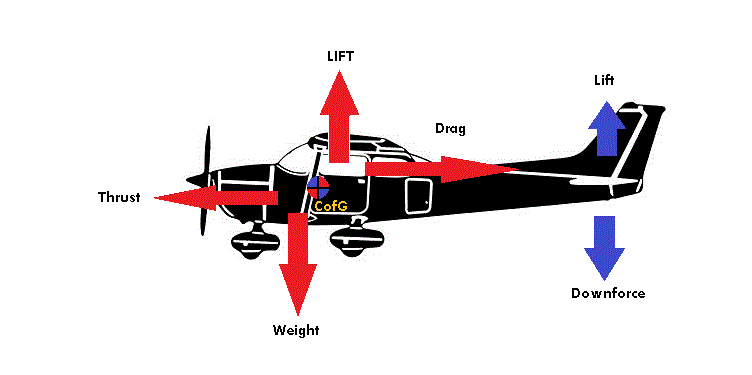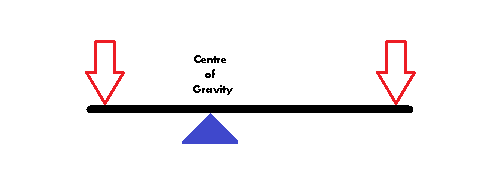In the previous post I made a correlation between lift and pitch, it’s been bugging me because it was a bit loose and there is a lot more to it, so perhaps an elaboration of the bullet points is in order.
A plane has a number of forces acting upon it.
Cue a diagram:
The position of the Centre of Gravity is key and any given aeroplane will have defined limits on how far forward or rearward it can be (outside of which the plane is illegal to fly!).
The reason for this is that the position of the Centre of Gravity impacts planes stability in pitch. This is because the distance between the Centre of Gravity and the planes stabaliser (seen above creating lift or downforce), defines the leverage the stabaliser has.
If the distance is very long (centre of gravity is very far forward), then the plane will be very stable in pitch. However, too stable and the pilot will have no control of the plane.
If the distance is very short (centre of gravity very rearwards), then the plane will be unstable – highly manoeuvrable, but in the extreme it will make the plane tail heavy and the pilot will not be able to stop the plane from wanting to pitch nose up.
So using the diagram above, if the downforce generated by the stabliser increases and overcomes weight the plane will start to pitch nose up. If the stabaliser starts to generate lift, the plane pitches nose down.
There is a couple around the CofG for thrust and drag, if thrust increases considerably this to will make the plane pitch up……but this is due to a secondary effect. Increasing thrust will impact the lift/downforce forces – and they will dictate pitch. Thrust/Drag alone do not make an object change its pitch, you can think of a plane as a car at this point…..but add wings to a car and it becomes a plane because now you have lift & downforce which will either push the thing into the ground or make it take off.
Pitch of an airplane is dictated by its centre of gravity and the forces acting forward or aft in a vertical direction around that lever.
If the net forces acting down on the right of the lever is greater than the net forces acting down on the left of the lever……the plane will be pitched nose up. If it’s reversed, the plane will pitch nose down.
The first diagram shows that if extending flaps to 10 degrees just increased lift, the plane would pitch nose down – as it would pivot around the centre of gravity. The fact the plane (high wing designs) doesn’t do this, tells us that the extended flap is also having an effect on the forces generated by the stabaliser, which is outweighing lift/weight pivot.
So what’s going on?
The extended flap changes the shape of the wing, this changes the airflow off the wings trailing edge. On a high wing aeroplane design like on a Cessna, this increases the downwash striking the stabaliser. In turn this means the stabaliser generates more downforce.
We’re now back at the balance lever diagram, the increased downforce outweighs the lift/weight couple and causes the plane to pitch nose up.
Pitching nose up causes speed to reduce, reducing lift, causing the plane to pitch down and hey presto the plane is oscillating – until it balances itself out.
Most of the above has explained high wing designs, for low wing designs like the Piper Cherokee the principles are the same but the plane will pitch nose down. This is because in low wing designs the main wing and the stabaliser are roughly level, so now changing the shape by extending flaps causes less downwash to strike the stabaliser. The lift/weight couple has more effect because the stabalisers ability to produce lift is reduced.

